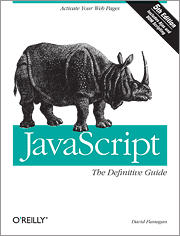
This is the latest edition of O'Reilly's bestselling JavaScript book: JavaScript: The Definitive Guide. This is the 5th edition already and it is completely updated to include web 2.0 stuff like Ajax.
Title: JavaScript: The Definitive Guide
Fifth Edition: August 2006
Author: David Flanagan
ISBN: 0-596-10199-6
Pages: 1018
This Fifth Edition is completely revised and expanded to cover JavaScript as it is used in today's Web 2.0 applications. This book is both an example-driven programmer's guide and a keep-on-your-desk reference, with new chapters that explain everything you need to know to get the most out of JavaScript, including:
Scripted HTTP and Ajax
XML processing
Client-side graphics using the

![]()
No comments:
Post a Comment